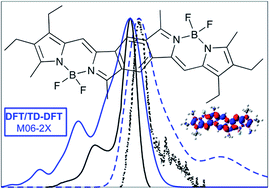Revisiting the optical signatures of BODIPY with ab initio tools†
Abstract

* Corresponding authors
a
CEISAM, UMR CNRS 6230, Université de Nantes, 2 Rue de la Houssinière, 44322 Nantes Cedex 3, France
E-mail:
denis.jacquemin@univ-nantes.fr
Tel: +33-2-51-12-55-64
b
Institut des Sciences Chimiques de Rennes, CNRS-Université de Rennes 1, 1 Av. du General Leclerc, 35042 Rennes Cedex, France
E-mail:
boris.leguennic@univ-rennes1.fr
Tel: +33-2-23-23-65-41
c Institut Universitaire de France, 103 bd Saint-Michel, F-75005 Paris Cedex 05, France

 Please wait while we load your content...
Something went wrong. Try again?
Please wait while we load your content...
Something went wrong. Try again?
S. Chibani, B. Le Guennic, A. Charaf-Eddin, A. D. Laurent and D. Jacquemin, Chem. Sci., 2013, 4, 1950 DOI: 10.1039/C3SC22265A
To request permission to reproduce material from this article, please go to the Copyright Clearance Center request page.
If you are an author contributing to an RSC publication, you do not need to request permission provided correct acknowledgement is given.
If you are the author of this article, you do not need to request permission to reproduce figures and diagrams provided correct acknowledgement is given. If you want to reproduce the whole article in a third-party publication (excluding your thesis/dissertation for which permission is not required) please go to the Copyright Clearance Center request page.
Read more about how to correctly acknowledge RSC content.
 Fetching data from CrossRef.
Fetching data from CrossRef.
This may take some time to load.
Loading related content
